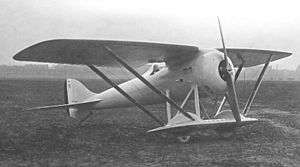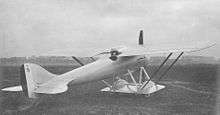Nieuport 31
The Nieuport Nie 31 or Nieuport 31 was a single-engine, single-seat monoplane or sesquiplane fighter aircraft designed and built in France in 1919.
| Nie 31 | |
|---|---|
 | |
| Nieuport 31 circa 1919 | |
| Role | Single-seat fighter |
| National origin | France |
| Manufacturer | Nieuport |
| First flight | 1919 |
| Number built | 2[1] |
Design and development
Though the Nie 31 (it had been flown and subsequently abandoned well before the company changed its name to Nieuport-Delage) was technically a sesquiplane, it could equally well be described as a shoulder-wing monoplane with a small foreplane. Its immediate predecessor was the Nieuport Madon, which had an ancillary lifting surface built around the axle of its wide-track undercarriage. The Nie 31 had a narrower-track undercarriage, but the second wing extended outwards beyond the wheels, which were faired into its upper surface; this wing and the axle were joined to the lower fuselage by a pair of near vertical N-form struts.[2]
The main plane was of low aspect ratio. In plan it had a rounded leading edge, straight trailing edge and square tips. Its roots were cut away to allow a better downward view from the cockpit. This was placed ahead of the trailing edge so the pilot looked forward over the wing; he had a faired headrest behind. The Nie 31's upper wing had ailerons but no flaps and was braced on each side by a parallel pair of aerofoil section struts stretching outwards from the bottom of the undercarriage struts. The lower wing had parallel chord and straight edges, providing a lifting surface with about 40% the area of the main plane. Both wings were fabric covered.[2]
The Nie 31 was powered by a 134 kW (180 hp) Le Rhone 9R nine-cylinder rotary engine, smoothly and completely cowled. It drove a two-blade propeller. The fuselage, like that of the earlier Nieuport Nie 29, was a smooth wooden monocoque shell of tulipwood, produced by winding thin spiral strips around a mould in a series of alternately handed layers and glueing them together. It tapered to the rear, where an almost delta-shaped tailplane was mounted at mid-height, carrying horn-balanced elevators. The fin was much less broad, with a straight-edged, balanced rudder extending down between the elevators below the lower fuselage, where there was a small dorsal fin.[2]

The Nie 31 was intended to carry twin 7.7 mm (0.303 in) Vickers machine guns. A flight test programme conducted through 1919 showed that the Nie 31 had excellent performance, especially given the low engine power, but Nieuport decided not to proceed with its development.[2]
Specifications
Data from Green and Swanborough[2]
General characteristics
- Crew: One
- Length: 6.60 m (21 ft 8 in)
- Wingspan: 8.60 m (28 ft 3 in)
- Height: 2.40 m (7 ft 10 in)
- Wing area: 18.0 m2 (194 sq ft)
- Empty weight: 500 kg (1,102 lb)
- Gross weight: 780 kg (1,720 lb)
- Powerplant: 1 × Le Rhone 9R nine cylinder rotary engine, 130 kW (180 hp)
- Propellers: 2-bladed fixed pitch
Performance
- Maximum speed: 230 km/h (140 mph, 120 kn)
- Endurance: 2.0 h
- Service ceiling: 6,000 m (20,000 ft) [1]
Armament
- 2 × 7.7 mm (0.303 in) Vickers machine guns fixed in nose
References
| Wikimedia Commons has media related to Nieuport 31. |
- "Les Avions Nieuport-Delage" (PDF). p. 31. Retrieved 3 April 2013.
- Green, William; Swanborough, Gordon (1994). The Complete Book of Fighters. Godalming, UK: Salamander Books. p. 437. ISBN 1-85833-777-1.